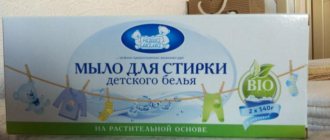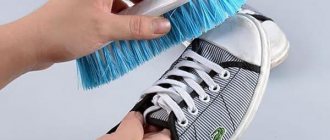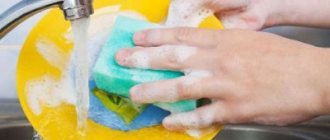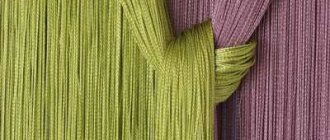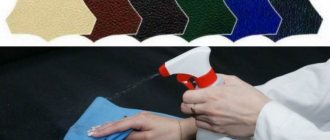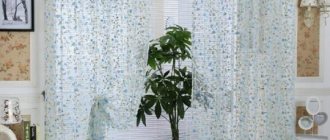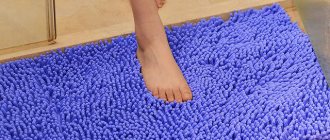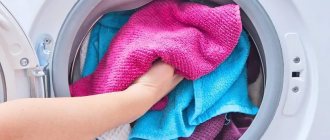Washing with washing powders is not suitable for everyone. For young children or people suffering from allergic diseases, it is necessary to look for alternative options.
Washing things with laundry soap can be a good replacement for chemical analogues. Read the article about whether and how to wash with laundry soap in an automatic washing machine and by hand.
Is it possible to wash it in a washing machine?
For washing in a washing machine, special detergents have been developed that foam little . In addition, they may contain special additives that soften water.
The soap contains organic fatty acids of animal and plant origin. Depending on their quantity, soap has different concentrations of fat content (from 40 to 80%).
The higher the concentration of fatty acids, the less it foams . Therefore, this product can be machine washed.
But with frequent use of bars, a greasy coating may form on the walls and internal parts of the machine. In order for the machine to work without breakdowns, you need to regularly clean it of scale and greasy film. To do this, start the idle mode at a temperature of 90C with citric acid. When using laundry soap in a vending machine
It is important to observe the dosage of detergent and carry out preventive maintenance at least once a month.
What to pay attention to
- You need to grate soap for a washing machine on a fine grater and before using it, it is advisable to leave it in water for a while so that it swells. This will eliminate the risk of soap particles sticking to clothes and to the walls of the washing machine;
- It is better to put less soap than more. Even 40 grams of soap can handle washing a full machine. A large amount of soap can foam too much, which will undoubtedly lead to problems in the operation of the washing machine;
- It is advisable to use soap for washing in soft water. If the water in the apartment is very hard, then soap films may form on the inner walls of the washing machine, which will have to be removed periodically. Therefore, it is worth checking your water for hardness before abandoning powders in favor of soap.
Everyone chooses the laundry detergent that suits their finances and preferences. For those who prefer natural products and want to keep fewer chemicals in their lives, laundry soap will be an ideal option.
You might be interested in
- What is the difference between laundry soap: dark, light, 72%, 70%, 65%
- How to make fabric softener at home
- Trays for powder and conditioner in the washing machine
Pros and cons of using
Soap contains fatty acids, which are obtained from animal fats and vegetable oils, and soda.
Thanks to this composition, it has the following qualities:
- Does not cause allergic reactions. Suitable for the delicate skin of newborns and allergy sufferers.
- Perfectly removes even the most difficult stains. If there is a dirty stain, you can just soap it, let it sit for 15-20 minutes and wash it. The stain will be removed.
- Does not destroy tissue. After washing, the fabric remains soft.
- Saving money. The cost of one soap bar is several times less than the cost of a standard pack of washing powder for an automatic machine.
The disadvantages include:
Silk and wool items cannot be washed.- It dissolves poorly in cold water and can form flakes that will settle on the walls of equipment.
- Requires some time to prepare. The bar needs to be grated or a gel prepared. When using liquid soap, you don’t have to waste time on preparation.
- Some housewives note a not very pleasant smell. But if you add a few drops of essential oil to the gel, the smell will become pleasant.
Do-it-yourself washing powder for an automatic washing machine: 7 recipes
To make laundry detergent at home, in addition to the ingredients, you should prepare materials and tools. You will need:
- mixing container (bucket, plastic container);
- container with a lid for storage (glass, plastic);
- mixing spatula or spoon;
- fine grater;
- measuring cup or washing powder dispenser.
In accordance with the purpose (for whitening, children's clothing, disinfection), different mixtures are prepared, differing in the number of constituent substances. Below are seven of the most used recipes.
With soda
Peculiarities. There are several options for preparing washing powder from laundry soap and soda. In fact, none of the homemade powders can do without these components, together or separately. The components enhance each other's action. For washing, 72% soap (tar, baby, laundry), ground on a grater, is best suited.
Components:
- baking soda - 500 g;
- soda ash (linen) - 400 g;
- soap - 200 g;
- aromatic oil (optional).
How to do
- Mix crushed soap with types of soda.
- Stir (shake in a closed jar).
- If desired, add a drop of oil and stir again.
Baking soda is more aggressive than baking soda. To enhance the cleaning effect, it is recommended to completely replace the food powder with calcined one. Baking soda dries out the skin, so rubber gloves should be used when washing by hand.
With vinegar
Peculiarities. A powder for washing clothes is prepared from soap and soda powder, with the addition of 9% vinegar. This will help soften the water and preserve the color of the fabric. Only clear vinegar should be used, otherwise the pink or caramel color will remain on the laundry.
Components:
- soap shavings - 150-200 g;
- baking soda and laundry soda - 200 g each;
- vinegar - two tablespoons;
- fragrant oil.
How to do
- Mix two types of soda with shavings.
- Pour in vinegar.
- Add three to five drops of oil to eliminate the vinegar smell.
With borax
Peculiarities. Borax is a disinfectant that is used as a thickener or cleaner. It is a powdery substance used in dry or diluted form. Borax can be replaced with boric acid, sold in pharmacies. Borax will make an effective DIY laundry detergent for children's clothes.
Components:
- shavings of coconut or laundry soap - 200 g;
- borax - 200 g;
- baking soda - 500 g;
- aromatic oil - if desired.
How to do
- Mix the shavings with soda and tetraborate.
- Add oil if desired.
- Dry the mixture next to the battery.
- Pour into a suitable container.
- Before use, dilute with water and pour into the car.
If a liquid boron solution is used, adding one or two teaspoons is sufficient. It is better to store the mixture in a closed container.
From citric acid and soap
Peculiarities. The composition preserves the color of the fabric, but corrodes various contaminants. Lemon juice gently cleans silk and wool items. After washing, the laundry acquires a pleasant light aroma.
Components:
- citric acid - three tablespoons;
- laundry soap - one bar;
- baking soda and baking soda - 500 g each;
- salt - two tablespoons.
How to do
- Rub the soap.
- Pour two types of soda into the shavings.
- “Salt” and add acid.
- Stir, pour into a jar with a lid.
- If desired, add fragrance oil for scent.
Soda has the property of bleaching fabrics and removing color. Therefore, its amount can be reduced, or not used at all for colored items.
With peroxide
Peculiarities. The solution whitens clothes. It can be prepared in advance and stored in the refrigerator, but no more than a month. Before washing, wet the stains with the solution and then add it to the machine.
Components:
- hydrogen peroxide - one glass;
- vinegar solution - half a glass;
- lemon juice - one tablespoon;
- water - half a glass;
- natural flavoring - optional.
How to do
- Mix peroxide with water.
- Add vinegar solution and juice.
- Add a few drops of aromatic oil.
- Stir and pour into a convenient bottle.
Homemade stain remover is made from peroxide, baking soda and dishwashing liquid. All ingredients are mixed in equal proportions (one tablespoon at a time). The mixture is applied to the stain and rubbed into the fabric with a sponge or brush. After two minutes, the product is washed off, and the item is washed in the machine in the usual way.
Laundry capsules
Peculiarities. From peroxide, soda powder, vinegar solution and magnesium sulfate (sold in pharmacies) you get dry tablets that are placed in universal containers, suitable for full washing, including cleansing and conditioning.
Components:
- laundry soda - 350 g;
- laundry soap - one bar;
- magnesium sulfate - two tablespoons;
- peroxide - three tablespoons;
- vinegar solution (9%) - 50 ml;
- fragrance oil;
- baking tray;
- parchment;
- molds (for ice cream or “bombs”).
How to do
- Rub the soap.
- Add sulfate and soda.
- Add peroxide and stir.
- Pour in the vinegar solution and add a drop of oil.
- Stir until the mixture resembles wet sand.
- Prepare a baking sheet, cover with paper.
- Use molds to make semi-circular tablets.
- Place on a baking sheet and dry at 100°C for several minutes. You can do without an oven by leaving the tablets to dry for a day.
Liquid product
Peculiarities. With a little time, it’s easy to prepare liquid laundry detergent yourself. The consistency is similar to a thick gel.
Components:
- laundry soap - 200 g;
- borax - half a glass;
- laundry soda - one glass;
- water - by eye;
- aromatic oil - one teaspoon.
How to do
- Pour the grated soap into the pan.
- Pour water until the liquid completely covers the chips.
- Cook the mixture over low heat until a cloudy, thick solution is obtained.
- Boil half a bucket of water.
- Add borax, soda, and warm soap.
- Stir, add water to the brim.
- Cover with a lid or board and leave for eight hours.
- Add oil to the cooled solution.
- Pour into suitable bottles and store.
Mustard is another home remedy that deals with various stains and whitens laundry. Mustard is not used as a washing powder in an automatic machine (it will swell and clog the drains); it is only suitable for hand washing, when you wash things yourself. The laundry is soaked in a mustard solution, individual stains are treated with mustard paste (a mixture of powder with a small amount of water).
Features of manual and machine processing
There are some features and differences for hand and machine washing using soap.
In the washing machine
Detergents with low foam formation have been specially developed for washing machines. Laundry soap meets these requirements. To use it in an automatic machine, the bar is crushed.
Features: fabrics of different composition produce different amounts of foam. Natural silk and wool fabrics foam the water more, so less detergent is used to wash them.
To wash a kilogram of dry laundry, add 2 tablespoons of shavings.
Manually
Hand washing will require more physical effort. It has some features:
Before starting the process, you need to sort things by color and wash colored items separately from white ones.- Heavily soiled laundry should be pre-soaked in soapy water for 30-60 minutes.
- If there are dirty spots, you must first wet them, rub them with soap and leave for 20-30 minutes. After this, rub with a brush or with your hands on a grater.
- You need to rinse the laundry several times until the foam is completely washed away.
It will be difficult to wash heavily soiled items by hand, because... Dirt washes off well in hot water. Your hands won't be able to withstand that temperature.
What fabrics can be washed?
The soap is suitable for washing items made from natural and synthetic fabrics such as cotton, linen, polyester,
You can wash woolen items with laundry soap, but only if you do it with your hands. When washing in a machine, wool quickly accumulates soap suds and pills . It is quite difficult to rinse foam out of wool.
When hand washing woolen items, first make a soap solution and only then immerse the item in it. Lathering wool is not recommended.
Natural silk fabrics also foam the soap solution well. Therefore, when machine washing, the dosage of soap is reduced.
Positive qualities of soap
Laundry soap in bars is hypoallergenic , it is dominated by fatty acids obtained from natural products, and also contains vegetable oils. Ideal for washing children's clothes and indispensable for people prone to allergic dermatitis.
Special powders have been created for washing machines that do not foam much. Laundry soap has the same property, which is why it is suitable for automatic machines when used in the right dosage.
Note: the intensity of foam formation depends on the type of fabric. When washing woolen items, it is larger, so you need to put in less product.
The pungent smell of bars, to which people of the older generation were accustomed, has disappeared. A faint aroma is felt only during washing; after the laundry is completely dry, it disappears.
“Liquid” laundry soap appeared on store shelves. The production process could not do without the use of synthetic surfactants, abbreviated as surfactants. The product is somewhat different from real hypoallergenic laundry soap in bars, which does not contain them in its composition.
Which is better to choose: liquid, solid, powder?
The action of soap is based on the fact that the fatty acids contained in its composition react with dirt and wash it out of the fabric fibers with the help of foam. Therefore, the more fatty acids in the bar, the more effective its action .
Depending on the percentage of fatty acids, the industry produces several types of solid soap:
- Category 1 , contains 70.5 – 72% fatty acids;
- category 2 , consisting of 65-69% FA;
- Category 3 , contains up to 64% of components.
Depending on the degree of concentration of fatty acids, the color of the bar changes. The more there are, the darker the piece.
Nowadays you can find laundry soap of different consistencies on sale:
- bar,
- liquid,
- powdery.
Soap powder is a crushed bar version . Soap is no different from bar soap, only crushed into crumbs. It is convenient to pour it into the drum or powder tray in the washing machine.
As for liquid soap, the situation is different. It is, of course, convenient to use for machine washing. As for the composition of this product, it has nothing in common with traditional soap.
If you read its composition indicated on the label, you can find surfactants, fragrances and other chemical components in it. Liquid soap has nothing in common with laundry soap.
The technology for the production of laundry soap and the substances included in its composition do not allow it to be produced in liquid form.
Choosing laundry soap
The main characteristic of laundry soap is the content of fatty acids
The following types of laundry soap can be used in machine washing:
- solid soap of various types and grades with a standard fat concentration from 65 to 72%;
- soap with various additives of olive oil, glycerin, extracts from various herbs, protein bleaching enzymes;
- liquid types of laundry soap with a low fat concentration of 30 to 40% - the best option for machine washing, which does not require additional preparation of soap and is ready for use;
- types of laundry soap for children's clothing containing additives from tar, mink fat, glycerin, and medicinal plant extracts;
- soap containing palm or coconut oil - it forms little foam, is easily washed off, has no strong odor and leaves virtually no residue on the internal surfaces of the car.
When choosing laundry soap, you should pay attention to its composition and the content of protein enzymes (enzymes) intended for bleaching. This product should not be used for washing silk and woolen items due to the risk of damaging the fabric structure.
Detergents based on laundry soap are used in all machine wash modes. However, it should be remembered that in delicate mode with a low temperature, the soap solution will dissolve more slowly and be washed off less easily. In this case, you can reduce the dosage of the product and be sure to use an additional rinse.
How to wash clothes automatically?
The soap bar does not dissolve well, so it must first be prepared for use in the car.
If the bar is in the form of jelly
Grate 100 grams of soap bar on a fine grater. Pour 1 liter of hot water over the shavings. Heat over low heat until completely dissolved.- Dissolve 3 tablespoons of soda ash in 3 liters of water.
- Mix both solutions together.
- To add a pleasant smell to the mixture after cooling, add 10-15 drops of any essential oil.
- Pour the solution into a convenient container. Wait until it cools completely (the solution should acquire a jelly-like consistency), after which it can be used.
For one cycle, 200 grams of jelly are added to the drum.
Shavings
Another easier way to use bar soap is in the form of shavings. It requires less time.
For this method, the piece is grated on a fine grater. It is then poured into a drum or powder container. The shavings are taken at the rate of 2 tbsp. l. for 1 kg of laundry.
To improve the quality of washing, you can add soda to the shavings (3 tablespoons per piece) . The mixture should be stored in a container with a tightly closed lid so that the soda does not absorb moisture.
The video will show you how to wash with laundry soap in a washing machine:
Solution
For better dissolution, before use, dissolve the shavings in hot water (a glass of water per 2 tablespoons of shavings). The solution is poured into the powder tray.
Effect on clothing and water
At first glance, it may seem that washing clothes with simple laundry soap has only positive aspects: naturalness, absence of harmful chemicals, good results at a low cost. But it can harm not only the washing machine, leaving a greasy residue on its parts, but also some types of delicate fabrics.
You can protect your clothes and washing machine from the negative effects of washing with this product by following simple recommendations:
- soap consumption should be 30 g per 10 liters of water;
- You can wash it with laundry soap in a machine at a temperature of no more than 70°C, and optimally at 40°C.
Also, when calculating the required amount, you need to take into account that softening hard water will take about 30% of the total amount of soap. Therefore, in order not to increase its amount, soda is added to the water as a softener. You can visually understand how hard the water is by lathering soap in your hands under running water. Poor foaming indicates high water hardness.
Laundry solid and liquid laundry soap is a time-tested product that many housewives like to resort to. You can use it in a modern washing machine, but you need to do it correctly. Then the washed items will delight you with their cleanliness, and the machine will serve you well for many years.
Hand processing
Children's or delicate items are washed by hand. To do this, the soap is grated, dissolved in a bowl of warm water and washed. If the laundry is too dirty, then soak it in a soapy solution for 1-2 hours.
To wash stained items, proceed as follows:
moisten things with warm water;- lightly squeeze;
- I soap the dirty spot;
- soaped items are left to lie for 20-30 minutes without water;
- pour warm water, wash the stain with a soft brush.
After finishing washing, the laundry should be rinsed well 3-5 times.
Prevention of breakdowns of household appliances
When using soap, a greasy film remains on the parts of the automatic machine. If you use it for a long time, it can lead to equipment breakdowns.
To reduce the likelihood of breakage, you need to include an additional rinse after each cycle.
In addition, 1-2 times a month you need to run a dry wash at maximum temperature using citric acid or soda ash . This will help dissolve fat deposits.
If laundry soap is not used constantly, but for children's clothes, then subsequent washing with ordinary powders will help wash off the plaque.
Maintenance of the machine after washing with soap
If you plan to occasionally replace regular powder with laundry soap, then you don’t need to worry about a possible breakdown of the machine. In one-time cycles there will be no thick adhesive layer, so you can safely wash baby clothes, diapers and towels with a brown bar. To completely protect the machine, it is enough to run another program after finishing washing, adding a little vinegar and baking soda to the dispenser.
Those who want to completely replace household chemicals with laundry soap will have to take the prevention of possible contamination more seriously. Now you will need careful care and regular cleaning. The nature and extent of cleaning procedures depends on the quality of tap water.
Hard tap water accelerates the formation of plaque and increases the “sticking” of fat to the parts of the washer.
With soft water, no special intervention is required. You just need to rinse the machine as often as possible: run a “idle” cycle after each wash, plus an additional cycle when you finish using the washer. It is also recommended to constantly wipe the drum, cuff and detergent tray. It is important to carefully examine the “insides” of the machine for the presence of suspicious deposits and scale. Regular cleaning will not hurt either: once every 3-4 months, turn on the “empty” program, adding vinegar, citric acid, soda or a chemical cleaner to the dispensary.
If the water is too hard, then the risk of contamination of the machine due to the sticky soap composition increases. The fact is that the impurities and substances present in such a liquid accelerate the formation of plaque and increase the “sticking” of fat to the parts. The frequency of preventive cleaning is increasing - it is better to clean the washing machine every 2-3 weeks.
In any case, it is not difficult to keep the machine safe and sound. Many years of experience of housewives shows that switching to environmentally friendly soap without unpleasant consequences is possible. The main thing is to control the process, be responsible and follow the dosage.
Reviews from people
There is no clear opinion about the quality of using laundry soap. Most consumers agree that it does not cause allergies . And this product is excellent for choosing when washing clothes for newborns and allergy sufferers.
The only downside is the not very pleasant smell of the items after washing. But to eliminate it, it is recommended to use essential oil or rinse things with the addition of apple cider vinegar or citric acid.
You can read reviews about using laundry soap here and here.
You will find maximum useful information about washing clothes and various fabric products here.
Useful properties of detergent
Laundry soap will be a good alternative to even expensive washing powder. It is considered an environmentally friendly detergent, since it contains no harmful components. Dark soap bars are produced from fatty acids, with a small addition of vegetable oil and various fats of animal origin. Many manufacturers add soda, thanks to which it acquires antibacterial properties.
Pediatricians advise young mothers to use laundry soap for washing children's clothes. This product rinses well and is hypoallergenic. You can use laundry soap to care for children's things on the same basis as baby soap.
The linen of small children and allergy sufferers can also be washed with tar soap, which is made on the basis of birch tar. Such products are often used for cosmetic and medicinal purposes, but they are also suitable for washing clothes. The birch tar included in the composition has a detrimental effect on many microorganisms and fungi, thereby disinfecting things.
It is especially good to wash socks, tights and rag shoes with tar soap. This can serve as a preventive measure for the fungus or prevent its further spread if the person is already sick.
You can wash children's clothes in a washing machine with tar soap; after drying, the laundry does not have a chemical smell and does not cause allergies in the child.
Laundry soap is used as first aid for animal bites. It cleans the wound well and disinfects the saliva that gets into it during a bite.
